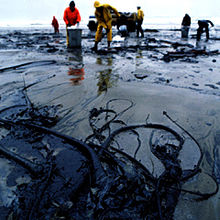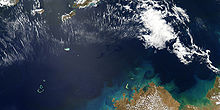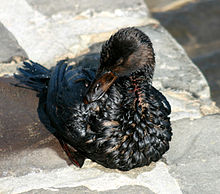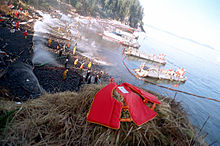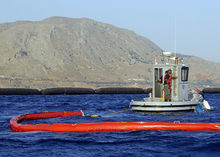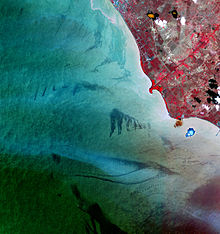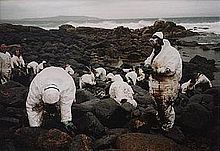- Oil spill
-
An oil spill is the release of a liquid petroleum hydrocarbon into the environment, especially marine areas, due to human activity, and is a form of pollution. The term is mostly used to describe marine oil spills, where oil is released into the ocean or coastal waters. Oil spills may be due to releases of crude oil from tankers, offshore platforms, drilling rigs and wells, as well as spills of refined petroleum products (such as gasoline, diesel) and their by-products, heavier fuels used by large ships such as bunker fuel, or the spill of any oily refuse or waste oil. Another significant route by which oil enters the marine environment is through natural oil seeps.[1]
Oil spills can be controlled by chemical dispersion, combustion, mechanical containment, and/or adsorption. Spills may take weeks, months or even years to clean up.[2]
Contents
Environmental effects
The oil penetrates into the structure of the plumage of birds and animals, reducing its insulating ability, thus making the birds more vulnerable to temperature fluctuations and much less buoyant in the water. It also impairs or disables birds' flight abilities to forage and escape from predators. As they attempt to preen, birds typically ingest oil that covers their feathers, causing kidney damage, altered liver function, and digestive tract irritation. This and the limited foraging ability quickly causes dehydration and metabolic imbalances. Hormonal balance alteration including changes in luteinizing protein can also result in some birds exposed to petroleum.[3]
Most birds affected by an oil spill die unless there is human intervention.[4][5] Some studies have suggested that, even after cleaning, less than 1% of oil soaked birds survive.[6], though it can also exceed 90% as in the case of the Treasure oil spill.[7] Heavily furred marine mammals exposed to oil spills are affected in similar ways as seabirds. Oil coats the fur of Sea otters and seals, reducing its insulation abilities and leading to body temperature fluctuations and hypothermia. Ingestion of the oil causes dehydration and impaired digestions. Because oil floats on top of water, less sunlight penetrates into the water, limiting the photosynthesis of marine plants and phytoplankton. This, as well as decreasing the fauna populations, affects the food chain in the ecosystem.[citation needed] There are three kinds of oil-consuming bacteria. Sulfate-reducing bacteria (SRB) and acid-producing bacteria are anaerobic, while general aerobic bacteria (GAB) are aerobic. These bacteria occur naturally and will act to remove oil from an ecosystem, and their biomass will tend to replace other populations in the food chain. Oil may also cause the death of an animal by entering the animal’s lungs or liver. The animal will then be poisoned by the oil. Oil also can kill an animal by blinding it. The animal will not be able to see and be aware of their predators. If they are not aware of other animals, they may be eaten.
Cleanup and recovery
Cleanup and recovery from an oil spill is difficult and depends upon many factors, including the type of oil spilled, the temperature of the water (affecting evaporation and biodegradation), and the types of shorelines and beaches involved.[8]
Methods for cleaning up include:[9]
- Bioremediation: use of microorganisms[10] or biological agents[11] to break down or remove oil.
- Bioremediation Accelerator: Oleophilic, hydrophobic chemical, containing no bacteria, which chemically and physically bonds to both soluble and insoluble hydrocarbons. The bioremedation accelerator acts as a herding agent in water and on the surface, floating molecules to the surface of the water, including solubles such as phenols and BTEX, forming gel-like agglomerations. Undetectable levels of hydrocarbons can be obtained in produced water and manageable water columns. By overspraying sheen with bioremediation accelerator, sheen is eliminated within minutes. Whether applied on land or on water, the nutrient-rich emulsion creates a bloom of local, indigenous, pre-existing, hydrocarbon-consuming bacteria. Those specific bacteria break down the hydrocarbons into water and carbon dioxide, with EPA tests showing 98% of alkanes biodegraded in 28 days; and aromatics being biodegraded 200 times faster than in nature they also sometimes use the hydrofireboom to clean the oil up by taking it away from most of the oil and burning it.[12]
- Controlled burning can effectively reduce the amount of oil in water, if done properly.[13] But it can only be done in low wind,[citation needed] and can cause air pollution.[14]
- Dispersants act as detergents, clustering around oil globules and allowing them to be carried away in the water.[15] This improves the surface aesthetically, and mobilizes the oil. Smaller oil droplets, scattered by currents, may cause less harm and may degrade more easily. But the dispersed oil droplets infiltrate into deeper water and can lethally contaminate coral. Recent research indicates that some dispersants are toxic to corals.[16]
- Watch and wait: in some cases, natural attenuation of oil may be most appropriate, due to the invasive nature of facilitated methods of remediation, particularly in ecologically sensitive areas such as wetlands.[17]
- Dredging: for oils dispersed with detergents and other oils denser than water.
- Skimming: Requires calm waters
- Solidifying: Solidifiers are composed of dry hydrophobic polymers that both adsorb and absorb. They clean up oil spills by changing the physical state of spilled oil from liquid to a semi-solid or a rubber-like material that floats on water. Solidifiers are insoluble in water, therefore the removal of the solidified oil is easy and the oil will not leach out. Solidifiers have been proven to be relatively non-toxic to aquatic and wild life and have been proven to suppress harmful vapors commonly associated with hydrocarbons such as Benzene, Xylene, Methyl Ethyl, Acetone and Naphtha. The reaction time for solidification of oil is controlled by the surf area or size of the polymer as well as the viscosity of the oil. Some solidifier product manufactures claim the solidified oil can be disposed of in landfills, recycled as an additive in asphalt or rubber products, or burned as a low ash fuel. A solidifier called C.I.Agent (manufactured by C.I.Agent Solutions of Louisville, Kentucky) is being used by BP in granular form as well as in Marine and Sheen Booms on Dauphin Island, AL and Fort Morgan, MS to aid in the Deepwater Horizon oil spill cleanup.
- Vacuum and centrifuge: oil can be sucked up along with the water, and then a centrifuge can be used to separate the oil from the water - allowing a tanker to be filled with near pure oil. Usually, the water is returned to the sea, making the process more efficient, but allowing small amounts of oil to go back as well. This issue has hampered the use of centrifuges due to a United States regulation limiting the amount of oil in water returned to the sea.[18]
Equipment used includes:[13]
- Booms: large floating barriers that round up oil and lift the oil off the water
- Skimmers: skim the oil
- Sorbents: large absorbents that absorb oil
- Chemical and biological agents: helps to break down the oil
- Vacuums: remove oil from beaches and water surface
- Shovels and other road equipments: typically used to clean up oil on beaches
Prevention
- Secondary containment - methods to prevent releases of oil or hydrocarbons into environment.
- Oil Spill Prevention Containment and Countermeasures (SPCC) program by the United States Environmental Protection Agency.
- Double-hulling - build double hulls into vessels, which reduces the risk and severity of a spill in case of a collision or grounding. Existing single-hull vessels can also be rebuilt to have a double hull.
Environmental Sensitivity Index (ESI) mapping
Environmental Sensitivity Index (ESI) maps are used to identify sensitive shoreline resources prior to an oil spill event in order to set priorities for protection and plan cleanup strategies.[19][20] By planning spill response ahead of time, the impact on the environment can be minimized or prevented. Environmental sensitivity index maps are basically made up of information within the following three categories: shoreline type, and biological and human-use resources.[21]
Shoreline type
Shoreline type is classified by rank depending on how easy the garet would be to clean up, how long the oil would persist, and how sensitive the shoreline is.[22] The floating oil slicks put the shoreline at particular risk when they eventually come ashore, covering the substrate with oil. The differing substrates between shoreline types vary in their response to oiling, and influence the type of cleanup that will be required to effectively decontaminate the shoreline. In 1995, the US National Oceanic and Atmospheric Administration extended ESI maps to lakes, rivers, and estuary shoreline types.[21] The exposure the shoreline has to wave energy and tides, substrate type, and slope of the shoreline are also taken into account – in addition to biological productivity and sensitivity. The productivity of the shoreline habitat is also taken into account when determining ESI ranking.[23] Mangroves and marshes tend to have higher ESI rankings due to the potentially long-lasting and damaging effects of both the oil contamination and cleanup actions. Impermeable and exposed surfaces with high wave action are ranked lower due to the reflecting waves keeping oil from coming onshore, and the speed at which natural processes will remove the oil.
Biological resources
Habitats of plants and animals that may be at risk from oil spills are referred to as “elements” and are divided by functional group. Further classification divides each element into species groups with similar life histories and behaviors relative to their vulnerability to oil spills. There are eight element groups: Birds, Reptiles Amphibians, Fish, Invertebrates, Habitats and Plants, Wetlands, and Marine Mammals and Terrestrial Mammals. Element groups are further divided into sub-groups, for example, the ‘marine mammals’ element group is divided into dolphins, manatees, pinnipeds (seals, sea lions & walruses), polar bears, sea otters and whales.[21][23] Problems taken into consideration when ranking biological resources include the observance of a large number of individuals in a small area, whether special life stages occur ashore (nesting or molting), and whether there are species present that are threatened, endangered or rare.[24]
Human-use resources
Human use resources are divided into four major classifications; archaeological importance or cultural resource site, high-use recreational areas or shoreline access points, important protected management areas, or resource origins.[21][24] Some examples include airports, diving sites, popular beach sites, marinas, natural reserves or marine sanctuaries.
Estimating the volume of a spill
By observing the thickness of the film of oil and its appearance on the surface of the water, it is possible to estimate the quantity of oil spilled. If the surface area of the spill is also known, the total volume of the oil can be calculated.[25]
Film thickness Quantity spread Appearance in mm nm gal/sq mi L/ha Barely visible 0.0000015 0.0000380 38 25 0.370 Silvery sheen 0.0000030 0.0000760 76 50 0.730 First trace of color 0.0000060 0.0001500 150 100 1.500 Bright bands of color 0.0000120 0.0003000 300 200 2.900 Colors begin to dull 0.00004 0.0010000 1000 666 9.700 Colors are much darker 0.0000800 0.0020000 2000 1332 19.500 Oil spill model systems are used by industry and government to assist in planning and emergency decision making. Of critical importance for the skill of the oil spill model prediction is the adequate description of the wind and current fields. There is a worldwide oil spill modelling (WOSM) program.[26] Tracking the scope of an oil spill may also involve verifying that hydrocarbons collected during an ongoing spill are derived from the active spill or some other source. This can involve sophisticated analytical chemistry focused on finger printing an oil source based on the complex mixture of substances present. Largely, these will be various hydrocarbons, among the most useful being polyaromatic hydrocarbons. In addition, both oxygen and nitrogen heterocyclic hydrocarbons, such as parent and alkyl homologues of carbazole, quinoline, and pyridine, are present in many crude oils. As a result, these compounds have great potential to supplement the existing suite of hydrocarbons targets to fine tune source tracking of petroleum spills. Such analysis can also be used to follow weathering and degradation of crude spills.[27]
Largest oil spills
Oil spills of over 100,000 tons or 30 million US gallons, ordered by tons[a] Spill / Tanker Location Date *Tons of crude oil
(thousands)Barrels
(thousands)US Gallons
(thousands)References Kuwaiti oil fires [b]  Kuwait
KuwaitJanuary, 1991 - November, 1991 136,000-205,000 1,000,000-1,500,000 42,000,000-63,000,000 [28] Kuwaiti oil lakes [c]  Kuwait
KuwaitJanuary, 1991 - November, 1991 3,409-6,818 25,000-50,000 1,050,000-2,100,000 [29][30][31] Lakeview Gusher  United States, Kern County, California
United States, Kern County, CaliforniaMay 14, 1910 – September, 1911 1,200 9,000 378,000 [32] Gulf War oil spill [d]  Iraq, Persian Gulf and Kuwait
Iraq, Persian Gulf and KuwaitJanuary 19, 1991 - January 28, 1991 818–1,091 6,000–8,000 252,000–336,000 [29][33][34] Deepwater Horizon  United States, Gulf of Mexico
United States, Gulf of MexicoApril 20, 2010 – July 15, 2010 560-585 4,100-4,900 172,000-180,000 [35][36][37][38][39] Ixtoc I  Mexico, Gulf of Mexico
Mexico, Gulf of MexicoJune 3, 1979 – March 23, 1980 454–480 3,329–3,520 139,818–147,840 [40][41][42] Atlantic Empress / Aegean Captain  Trinidad and Tobago
Trinidad and TobagoJuly 19, 1979 287 2,105 88,396 [43][44][45] Fergana Valley  Uzbekistan
UzbekistanMarch 2, 1992 285 2,090 87,780 [46] Nowruz Field Platform  Iran, Persian Gulf
Iran, Persian GulfFebruary 4, 1983 260 1,907 80,080 [47] ABT Summer  Angola, 700 nmi (1,300 km; 810 mi) offshore
Angola, 700 nmi (1,300 km; 810 mi) offshoreMay 28, 1991 260 1,907 80,080 [43] Castillo de Bellver  South Africa, Saldanha Bay
South Africa, Saldanha BayAugust 6, 1983 252 1,848 77,616 [43] Amoco Cadiz  France, Brittany
France, BrittanyMarch 16, 1978 223 1,635 68,684 [43][46][46][48][49] MT Haven  Italy, Mediterranean Sea near Genoa
Italy, Mediterranean Sea near GenoaApril 11, 1991 144 1,056 44,352 [43] Odyssey  Canada, 700 nmi (1,300 km; 810 mi) off Nova Scotia
Canada, 700 nmi (1,300 km; 810 mi) off Nova ScotiaNovember 10, 1988 132 968 40,656 [43] Sea Star  Iran, Gulf of Oman
Iran, Gulf of OmanDecember 19, 1972 115 843 35,420 [43][46] Irenes Serenade  Greece, Pylos
Greece, PylosFebruary 23, 1980 100 733 30,800 [43] Urquiola  Spain, A Coruña
Spain, A CoruñaMay 12, 1976 100 733 30,800 [43] Torrey Canyon  United Kingdom, Isles of Scilly
United Kingdom, Isles of ScillyMarch 18, 1967 80–119 587–873 24,654–36,666 [43][46] Greenpoint oil spill  United States, Brooklyn, New York City
United States, Brooklyn, New York City1940 – 1950s 55– 97 400–710 17,000–30,000 [50] a One ton of crude oil is roughly equal to 308 US gallons or 7.33 barrels approx.; 1 oil barrel is equal to 35 imperial or 42 US gallons.
b Estimates for the amount of oil burned in the Kuwaiti oil fires range from 500,000,000 barrels (79,000,000 m3) to nearly 2,000,000,000 barrels (320,000,000 m3). 732 wells were set ablaze, while many others were severely damaged and gushed uncontrolled for several months. The fires alone were estimated to consume approximately 6,000,000 barrels (950,000 m3) of oil per day at their peak. However, it is difficult to find reliable sources for the total amount of oil burned. The range of 1,000,000,000 barrels (160,000,000 m3) to 1,500,000,000 barrels (240,000,000 m3) given here represents frequently-cited figures, but better sources are needed.
c Oil spilled from sabotaged fields in Kuwait during the 1991 Persian Gulf War pooled in approximately 300 oil lakes, estimated by the Kuwaiti Oil Minister to contain approximately 25,000,000 to 50,000,000 barrels (7,900,000 m3) of oil. According to the U.S. Geological Survey, this figure does not include the amount of oil absorbed by the ground, forming a layer of "tarcrete" over approximately five percent of the surface of Kuwait, fifty times the area occupied by the oil lakes.[30]
d Estimates for the Gulf War oil spill range from 4,000,000 to 11,000,000 barrels (1,700,000 m3). The figure of 6,000,000 to 8,000,000 barrels (1,300,000 m3) is the range adopted by the U.S. Environmental Protection Agency and the United Nations in the immediate aftermath of the war, 1991–1993, and is still current, as cited by NOAA and The New York Times in 2010.[51] This amount only includes oil discharged directly into the Persian Gulf by the retreating Iraqi forces from January 19 to 28, 1991. However, according to the U.N. report, oil from other sources not included in the official estimates continued to pour into the Persian Gulf through June, 1991. The amount of this oil was estimated to be at least several hundred thousand barrels, and may have factored into the estimates above 8,000,000 barrels (1,300,000 m3).See also
- Environmental issues with petroleum
- Environmental issues with shipping
- List of oil spills
- LNG spill
- Low-temperature thermal desorption
- National Oil and Hazardous Substances Pollution Contingency Plan
- Ohmsett (Oil and Hazardous Materials Simulated Environmental Test Tank)
- Oil Pollution Act of 1990 (in the US)
- Oil well
- Penguin sweater
- Project Deep Spill, the first intentional deepwater oil and gas spill
- Pseudomonas putida (used for degrading oil)
- S-200 (fertilizer)
- Spill containment
- Tarball
References
- ^ http://seeps.geol.ucsb.edu/
- ^ "Hindsight and Foresight, 20 Years After the Exxon Valdez Spill". NOAA. 2010-03-16. http://vimeo.com/10216588. Retrieved 2010-04-30.
- ^ C. Michael Hogan (2008), "Magellanic Penguin", GlobalTwitcher.com, ed. N. Stromberg.
- ^ Dunnet, G., Crisp, D., Conan, G., Bourne, W. (1982) "Oil Pollution and Seabird Populations [and Discussion]" Philosophical Transactions of the Royal Society of London. B 297(1087): 413–427
- ^ Untold Seabird Mortality due to Marine Oil Pollution, Elements Online Environmental Magazine.
- ^ "Expert Recommends Killing Oil-Soaked Birds". Spiegel Online. May 6, 2010. http://www.spiegel.de/international/world/0,1518,693359,00.html. Retrieved August 1, 2011.
- ^ AC Wolfaardt, AJ Williams, LG Underhill, RJM Crawford & PA Whittington (2009): Review of the rescue, rehabilitation and restoration of oiled seabirds in South Africa, especially African penguins Spheniscus demersus and Cape gannets Morus capensis, 1983–2005, African Journal of Marine Science, 31:1, 31-54
- ^ Lingering Lessons of the Exxon Valdez Oil Spill
- ^ Oil spill cleanup technology Patents and patent applications
- ^ "The Environmental Literacy Council - Oil Spills". Enviroliteracy.org. 2008-06-25. http://www.enviroliteracy.org/article.php/540.html. Retrieved 2010-06-16.
- ^ "Biological Agents". http://www.epa.gov/osweroe1/content/learning/bioagnts.htm.
- ^ "S-200 | NCP Product Schedule | Emergency Management | US EPA". Epa.gov. http://www.epa.gov/emergencies/content/ncp/products/s200.htm. Retrieved 2010-06-16.
- ^ a b "Emergency Response: Responding to Oil Spills". Office of Response and Restoration. National Oceanic and Atmospheric Administration. 2007-06-20. http://response.restoration.noaa.gov/topic_subtopic_entry.php?RECORD_KEY(entry_subtopic_topic)=entry_id,subtopic_id,topic_id&entry_id(entry_subtopic_topic)=184&subtopic_id(entry_subtopic_topic)=8&topic_id(entry_subtopic_topic)=1.
- ^ Oil Spills
- ^ "Detergent and Oil Spills". NEWTON BBS. 2002-10-12. http://www.newton.dep.anl.gov/askasci/chem00/chem00896.htm. Retrieved 2007-07-29.
- ^ Barry, Carolyn (2007). Slick Death: Oil-spill treatment kills coral, Science News vol. 172, p. 67.
- ^ Pezeshki, S. R., Hester, M. W., Lin, Q. & Nyman, J. A. (2000). The effects of oil spill clean-up on dominant US Gulf coast marsh macrophytes: a review. Environmental Pollution. 108: 129-139.
- ^ Fountain, Henry (2010-06-24). "Advances in Oil Spill Cleanup Lag Since Valdez". New York Times. http://www.nytimes.com/2010/06/25/us/25clean.html. Retrieved 2010-07-05.
- ^ "Environmental Sensitivity Index (ESI) Maps". http://response.restoration.noaa.gov/resource_resourcetopic.php?RECORD_KEY(resourcetopics)=resourcetopic_id&resourcetopic_id(resourcetopics)=37. Retrieved 2010-05-27.
- ^ "NOAA's Ocean Service Office of Response and Restoration". Response.restoration.noaa.gov. http://response.restoration.noaa.gov/. Retrieved 2010-06-16.
- ^ a b c d NOAA (2002). Environmental Sensitivity Index Guidelines, version 3.0. NOAA Technical Memorandum NOS OR&R 11. Seattle: Hazardous Response and Assessment Division, National Oceanic and Atmospheric Administration, 129p.
- ^ Gundlach, E.R. and M.O. Hayes (1978). Vulnerability of Coastal Environments to Oil Spill Impacts. Marine Technology Society. 12 (4): 18-27.
- ^ a b NOAA (2008). Introduction to Environmental Sensitivity Index maps. NOAA Technical Manual. Seattle: Hazardous Response and Assessment Division, National Oceanic and Atmospheric Administration, 56p.
- ^ a b IMO/IPIECA (1994). Sensitivity Mapping for Oil Spill Response. International Maritime Organization/ International Petroleum Industry Environmental Conservation Association Report Series, Volume 1. 22p.
- ^ Metcalf & Eddy. Wastewater Engineering, Treatment and Reuse. 4th ed. New York: McGraw-Hill, 2003. 98.
- ^ Anderson, E.L., E. Howlett, K. Jayko, V. Kolluru, M. Reed, and M. Spaulding. 1993. The worldwide oil spill model (WOSM): an overview. Pp. 627–646 in Proceedings of the 16th Arctic and Marine Oil Spill Program, Technical Seminar. Ottawa, Ontario: Environment Canada.
- ^ Wang, Z., M. Fingas, and D.S. Page. 1999. Oil spill identification. Journal of Chromatography A. 843: 369-411. doi:10.1016/S0021-9673(99)00120-X.
- ^ CNN.com, Kuwait still recovering from Gulf War fires, 3 Jan. 2003.
- ^ a b United Nations, Updated Scientific Report on the Environmental Effects of the Conflict between Iraq and Kuwait, 8 Mar. 1993.
- ^ a b United States Geological Survey, Campbell, Robert Wellman, ed. 1999. Iraq and Kuwait: 1972, 1990, 1991, 1997. Earthshots: Satellite Images of Environmental Change. U.S. Geological Survey. http://earthshots.usgs.gov, revised 14 Feb. 1999.
- ^ National Aeronautics and Space Administration, Goddard Space Flight Center News, 1991 Kuwait Oil Fires, 21 Mar. 2003.
- ^ Harvey, Steve (2010-06-13). "California's legendary oil spill". Los Angeles Times. http://articles.latimes.com/2010/jun/13/local/la-me-then-20100613. Retrieved 2010-07-14.
- ^ United States Environmental Protection Agency, Report To Congress United States Gulf Environmental Technical Assistance From January 27 - July 31 1991
- ^ National Oceanic and Atmospheric Administration, Office of Response and Restoration, Emergency Response Division, Incident News: Arabian Gulf Spills, updated 18 May 2010.
- ^ Campbell Robertson /Clifford Krauss (2 August 2010). "Gulf Spill Is the Largest of Its Kind, Scientists Say". The New York Times. New York Times. http://www.nytimes.com/2010/08/03/us/03spill.html?_r=1&hp. Retrieved 2 August 2010.
- ^ CNN (1 July 2010). "Oil disaster by the numbers". CNN. http://www.cnn.com/SPECIALS/2010/gulf.coast.oil.spill/interactive/numbers.interactive/index.html. Retrieved 1 July 2010.
- ^ Consumer Energy Report (20 June 2010). "Internal Documents: BP Estimates Oil Spill Rate up to 100,000 Barrels Per Day". Consumer Energy Report. http://www.consumerenergyreport.com/2010/06/20/internal-document-bp-estimates-spill-rate-up-to-100000-bpd/. Retrieved 20 June 2010.
- ^ Big Oil Plans Rapid Response to Future Spills
- ^ Khatchadourian, Raffi (March 14, 2011). "The Gulf War". The New Yorker. http://www.newyorker.com/reporting/2011/03/14/110314fa_fact_khatchadourian.
- ^ "IXTOC I". National Oceanic and Atmospheric Administration. http://www.incidentnews.gov/incident/6250. Retrieved 2008-11-03.
- ^ "Ixtoc 1 oil spill: flaking of surface mousse in the Gulf of Mexico". Nature Publishing Group. http://www.nature.com/nature/journal/v290/n5803/abs/290235a0.html. Retrieved 2008-11-03.
- ^ John S. Patton, Mark W. Rigler, Paul D. Boehm & David L. Fiest (1981-03-19). "Ixtoc 1 oil spill: flaking of surface mousse in the Gulf of Mexico". NPG (Nature Publishing Group). http://www.nature.com/nature/journal/v290/n5803/abs/290235a0.html. Retrieved 2007-07-29.
- ^ a b c d e f g h i j "Major Oil Spills". International Tanker Owners Pollution Federation. http://www.itopf.com/stats.html. Retrieved 2008-11-02.
- ^ "Atlantic Empress". Centre de Documentation de Recherche et d'Expérimentations. http://www.cedre.fr/uk/spill/atlantic/atlantic.htm. Retrieved 2008-11-10.
- ^ "Tanker Incidents". http://www.maritime-connector.com/ContentDetails/1479/gcgid/193/lang/English/Tanker-Incidents.wshtml. Retrieved 2009-07-19.
- ^ a b c d e "Oil Spill History". The Mariner Group. http://www.marinergroup.com/oil-spill-history.htm. Retrieved 2008-11-02.
- ^ "Oil Spills and Disasters". http://www.infoplease.com/ipa/A0001451.html. Retrieved 2008-11-16.
- ^ "Amoco Cadiz". National Oceanic and Atmospheric Administration. http://www.incidentnews.gov/incident/6241. Retrieved 2008-11-16.
- ^ [1][dead link]
- ^ Prud'homme, Alex (2010-05-14). "An Oil Spill Grows in Brooklyn". New York Times. http://www.nytimes.com/2010/05/16/opinion/16Prudhomme.html. Retrieved 2010-07-18.
- ^ Gulf Oil Spill Is Bad, but How Bad?, last updated 20 May 2010.
Further reading
- The World Almanac and Book of Facts, 2004
- Oil Spill Case Histories 1967-1991, NOAA/Hazardous Materials and Response Division, Seattle WA, 1992
- Nelson-Smith, Oil Pollution and Marine Ecology, Elek Scientific, London, 1972; Plenum, New York, 1973
Pollution Air pollution Acid rain · Air quality (Indoor) · Atmospheric dispersion modeling · Chlorofluorocarbon · Global dimming · Global distillation · Global warming · Ozone depletion · Particulates · SmogWater pollution Environmental impact of pharmaceuticals and personal care products · Environmental impact of shipping · Environmental monitoring · Eutrophication · Freshwater environmental quality parameters · Hypoxia · Marine debris · Marine pollution · Ocean acidification · Oil spill · Surface runoff · Thermal pollution · Urban runoff · Wastewater · Water quality · Water stagnation · Waterborne diseasesSoil contamination Bioremediation · Phytoremediation · Electrical resistance heating · Herbicide · Pesticide · Soil Guideline Values (SGVs)Radioactive contamination Actinides in the environment · Environmental radioactivity · Fission product · Nuclear fallout · Plutonium in the environment · Radiation poisoning · Radium in the environment · Uranium in the environmentOther types of pollution Inter-government treaties Major organizations DEFRA · Environment Agency (England and Wales) · Scottish Environment Protection Agency (Scotland) · U.S. EPA · EEA · GreenpeaceCategories:- Oil spills
- Environmental disasters
- Hazards
- Bird mortality
- Ocean pollution
- Product safety scandals
Wikimedia Foundation. 2010.

